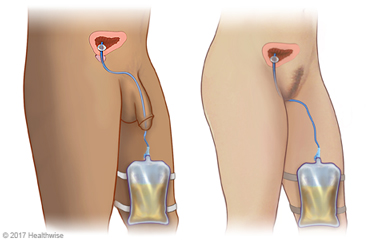
Introduction
A urinary catheter is a flexible plastic tube that's used to drain urine from the bladder when a person can't urinate. The catheter is placed into the bladder by inserting it through the urethra. The urethra is the opening that carries urine from the bladder to the outside of the body.
When the catheter is in the bladder, a small balloon is used to keep the catheter in place. The catheter lets urine drain from the bladder into a collection bag. Urinary catheters can be used in both men and women. A catheter that stays in place for a longer period of time is called an indwelling catheter.
A catheter may be needed because of certain medical conditions. These include an enlarged prostate or problems controlling urine. It may be used after surgery on the pelvis or urinary tract. Urinary catheters are also used when the lower part of the body is paralyzed.
When helping a loved one with a catheter, try to be relaxed. Caring for a catheter can be embarrassing for both of you. If you are calm and don't seem embarrassed, the person may feel more comfortable.
How do you take care of the catheter?
Wear disposable gloves when handling someone's catheter. Make sure to follow all of the instructions the doctor has given. And always wash your hands before and after you're done.
Here are some other things to remember when caring for someone's catheter:
- Make sure that urine is running out of the catheter into the urine collection bag. And make sure that the catheter tubing does not get twisted or bent.
- Keep the urine collection bag below the level of the bladder. At night it may be helpful to hang the bag on the side of the bed.
- Make sure that the urine collection bag does not drag and pull on the catheter.
- It's okay to shower with a catheter and urine collection bag in place, unless the doctor says not to.
- Check for swelling or signs of infection in the area around the catheter. Signs of infection include pus and irritated, swollen, red, or tender skin.
- Clean the area around the catheter daily with soap and water. Dry with a clean towel afterward.
- Do not apply powder or lotion to the skin around the catheter.
- Do not tug or pull on the catheter.
- Sexual intercourse may still be possible for people who wear a catheter. It's best to talk with a doctor about options.
How do you empty the bag?
The urine collection bag needs to be emptied regularly. It's best to empty the bag when it's about half full or at bedtime. If the doctor has asked you to measure the amount of urine, do that before you empty the urine into the toilet.
When you are ready to empty the bag, follow these steps:
- Put on disposable gloves.
- Remove the drain spout from its sleeve at the bottom of the collection bag. Open the valve on the spout.
- Let the urine flow out of the bag and into the toilet or a container. Do not let the tubing or drain spout touch anything.
- After you empty the bag, close the valve and put the drain spout back into its sleeve.
- Remove your gloves, and throw them away.
- Wash your hands with soap and water.
How do you care for someone after the catheter is removed?
After the catheter is taken out, the person may have trouble urinating. If this happens, try helping them sit in 8 to 10 centimetres (3 to 4 inches) of warm water (sitz bath). If the urge to urinate comes during the sitz bath, it may be easier for them to urinate while still in the bath.
Some burning may happen the first few times the person urinates. If the burning lasts longer, it may be a sign of an infection.
If the catheter causes irritation or a rash, wearing loose, cotton underwear may help.
Watch closely for changes in the person's health. Be sure to contact their doctor if you notice any problems or if they are unable to urinate at all.
Where can you learn more?
Go to https://www.healthwise.net/patientEd
Enter X535 in the search box to learn more about "Learning About How to Care for a Person's Indwelling Urinary Catheter".
